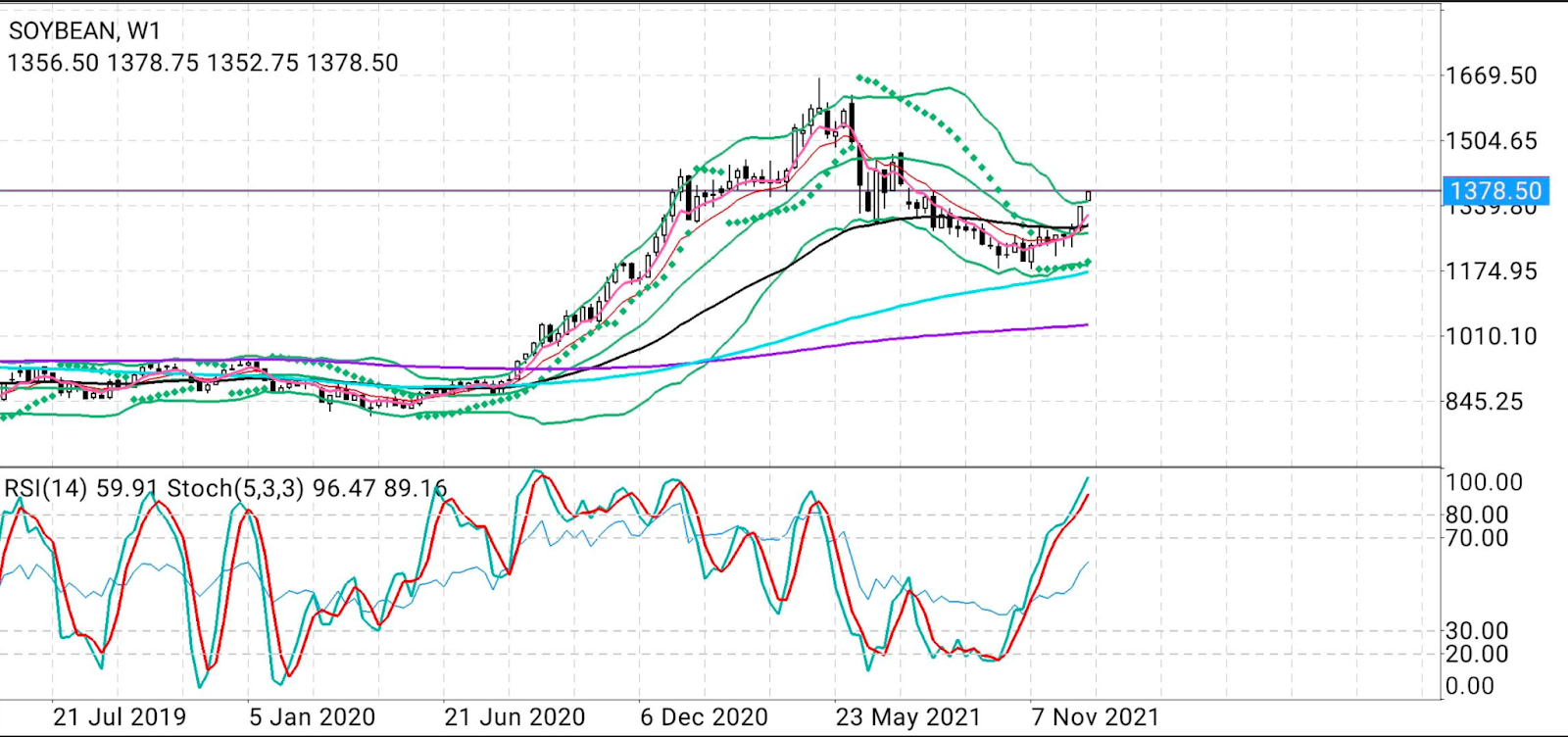Looks like some of Wall Street’s Christmas cheer has spilled over into the soy market.

All charts courtesy of skcharting.com
Prices of Chicago-traded soybeans are up 13% for December. That’s the highest monthly gain in more than five years for futures of the basic resource for soy milk, soy flour, and tofu, among others. December is also the first month in the green for soybeans after seven months in the red.
For 2021 itself, soybeans are on track to finish the year up 5% versus the 27% rally in corn and 26% gain in wheat.
If soybeans' annual gain compared with corn and wheat seems modest, consider this: At the beginning of October, they were down 5% for the year. At that time, the soybean market was the only one of the three major US agricultural markets that were in the red for the year. As well, at that point, soybeans were down almost 20% from their May high of $16.67 per bushel, hovering at a nine-month low of around $11.85.
In Monday’s trade, they hit a four-month high of almost $13.64.
The situation in soybeans reversed after a rally in nine out of the past 11 weeks, stoked by inordinate heat, dryness, and other unfavorable conditions in South America, where five major growers of the crop are based—Brazil, Argentina, Paraguay, Bolivia, and Uruguay.
Harvests of soy, as well as corn, are expected to be smaller in Brazil’s key southern growing region compared to a year ago due to parched fields, weather forecasters and consultancies told Reuters in a report published Monday.
“The government of the state of Parana in southern Brazil noted that 62% of soybeans were flowering to filling,” meteorologist John Baranick said in a commentary by weather forecasting service DTN.
“These crops cannot wait for more precipitation to come at a later time. They need it now.”
Parana is Brazil’s second largest soy growing region.
In the 2020/21 season, Brazil produced a record of 136 million tons of soybeans. The 2021/22 season will likely set a new high, though the number will be smaller than actual potential due to dry conditions, analysts said.
“Brazil could have soybeans ready for export by the end of February and the crop potential is up to 150 million tons although many are now starting to drop production outlooks due to the hot and dry weather,” said Jack Scoville, chief crop analyst at Chicago’s Price Futures Group.
He added:
“Ideas are now that Brazil can produce between 142 and 145 million tons of soybeans this year due to the losses in the south.”
All these have raised questions on where soybeans could be trading, at least technically, in the coming year.

Sunil Kumar Dixit, chief technical strategist at skcharting.com, thinks $14 and above per bushel is a safe bet.
“Bullishly positioned stochastic lines reading 96/89 and Relative Strength Index at 59 have enough firepower to challenge $14.23, which is the 50% Fibonacci level of the $16.66-$11.80 wave,” said Dixit. “From there, it should test the July 2021 high of $14.78.”
The current year-end rally in soybeans appeared initially aimed at filling the July 2021 gap of $13.86 - $13.90. This week's spike, however, left a new gap of $13.41 - $13.52 that needs to be filled when the down move starts, he said.
“Beyond January and toward March, we should see soybeans trading in the price band of $14.23 - $14.78 on the high side and $12.70 - $11. 70 on the lower end.”
Disclaimer: Barani Krishnan uses a range of views outside his own to bring diversity to his analysis of any market. For neutrality, he sometimes presents contrarian views and market variables. He does not hold a position in the commodities and securities he writes about.
